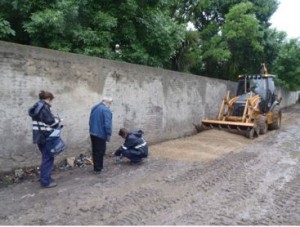
It is a small but powerful tool. The handheld XRF (X-ray fluorescence) analyzer can identify toxic particles in soil in about 30 seconds, allowing remediation crews to quickly locate and determine the extent of any contamination, and potentially begin life-saving cleanup without delays.
“Before getting an XRF, we had to manually collect soil samples, package them and somehow get them to an accredited laboratory, which might be located in a different country, for analysis,” says Dr. Jack Caravanos, director of research at Pure Earth and professor at NYU.
“When you have hundreds of plastic bags filled with soil and other biological contaminants, transporting them is quite a challenge.”

In Nigeria, we used the XRF to take samples of contaminated soil in Zamfara following one of the world’s worst outbreaks of lead poisoning that, according to some reports, has killed over 400 children to date.
In Uruguay, we used the XRF in the city of Montevideo to accelerate lead cleanup in the Aquiles Lanza neighborhood, where some residents make their living by burning e-waste to extract valuable materials like copper.
We collected over 100 soil readings in Montevideo, using the data to target the most polluted areas for remediation, and created a map showing the distribution of lead contamination in the neighborhood. We also documented lead readings before and after cleanup to measure effectiveness.

“In a project like this, the XRF allows us to provide a good model for rapid evaluation and cleanup of toxic hotspots that can be reproduced in other areas of Montevideo, in particular in neighborhoods around the Arroyo Pantanoso Basin,” says Sandra Gualtero, Pure Earth’s program director for Latin America at the time of the project.
In Ghana, we used the XRF to test soil at the Agbogbloshie dump site in Ghana.
In Armenia, we used an XRF to assess heavy metal contamination at a 10th century monastery in Akhtala.

Watch the video below to see our toxic site investigators in Brazil in action using the XRF.





